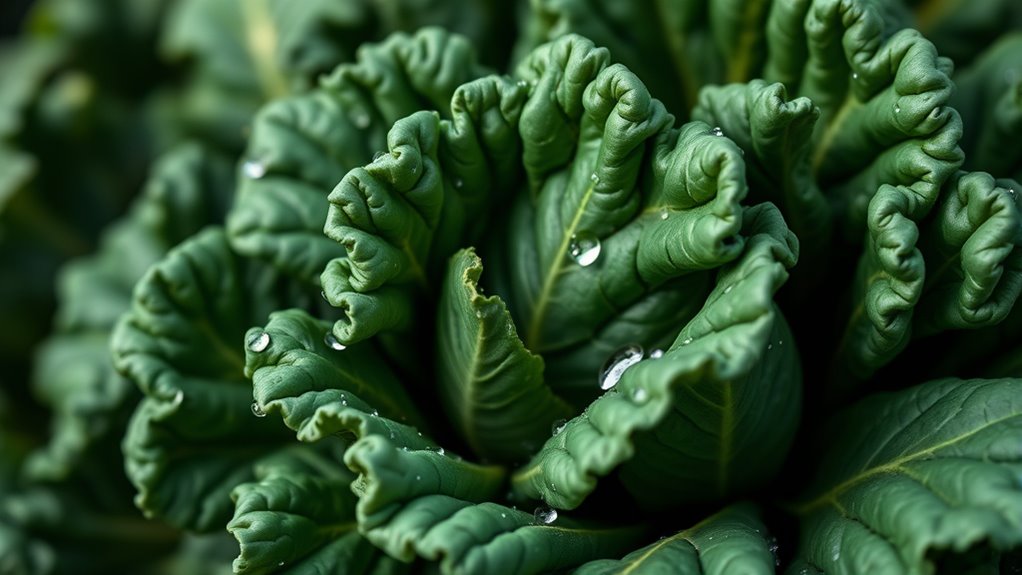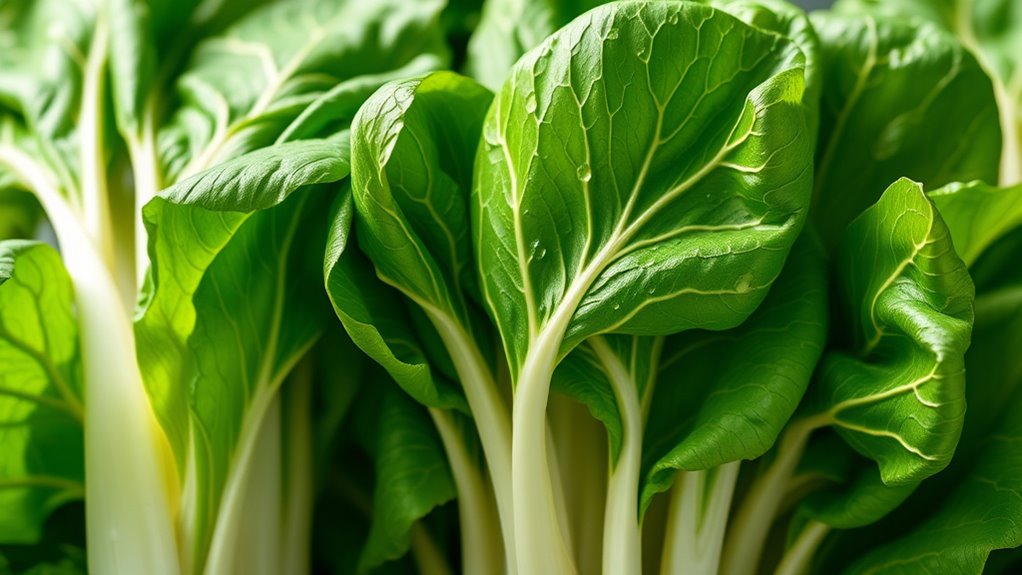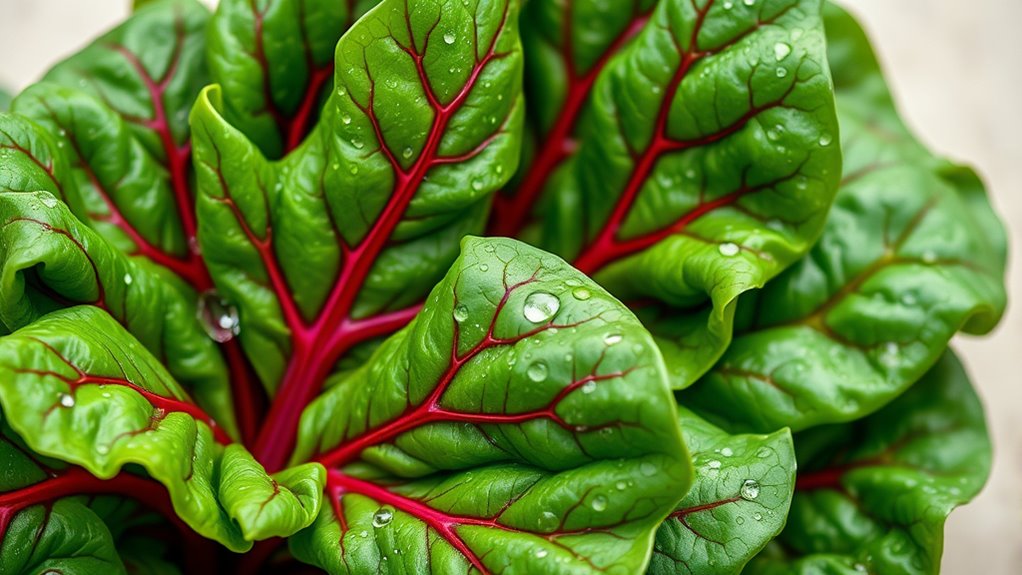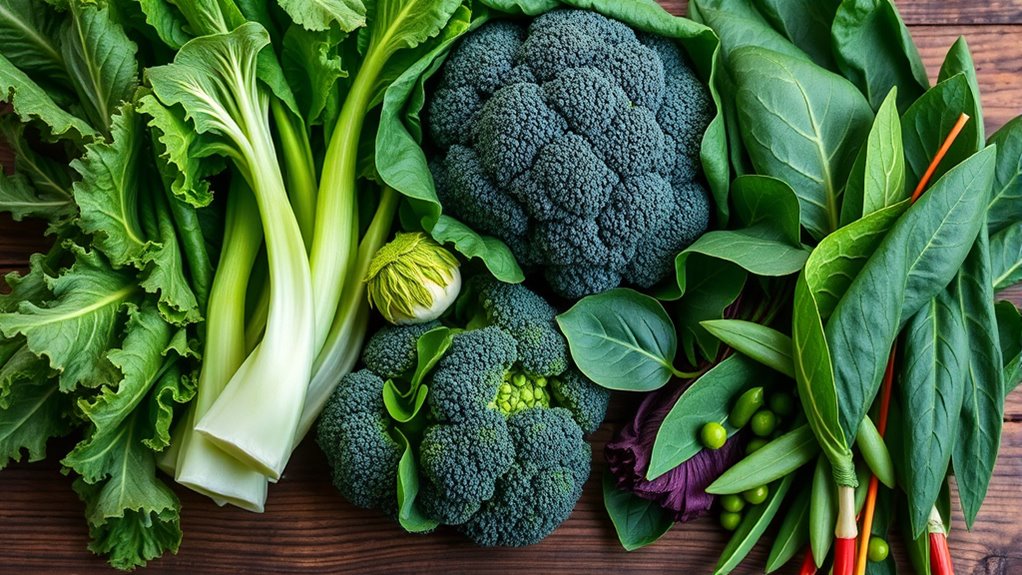If you’re looking for calcium without dairy, leafy greens like mustard greens, spinach, and Swiss chard are your best options. They offer more calcium per serving than milk and come with additional nutrients like magnesium and vitamins. These greens are versatile and easy to include in your diet through salads, sautés, or smoothies. Keep exploring, and you’ll uncover how to maximize their benefits for strong bones and overall health.
Key Takeaways
- Mustard greens provide over 200 mg of calcium per serving, surpassing milk’s calcium content.
- Spinach and Swiss chard are nutrient-dense greens that support bone health with high calcium levels.
- Cooking greens reduces oxalates, enhancing calcium absorption and bioavailability.
- Greens can be prepared in versatile ways—sautéed, raw, steamed, or added to smoothies—for enjoyable, dairy-free calcium intake.
- Sourcing greens from organic farmers ensures high quality and maximum nutrient retention for optimal health benefits.
Kale: The Calcium Powerhouse

Kale stands out as a top plant-based source of calcium, making it an excellent alternative for those avoiding dairy. Its high calcium content supports strong bones and overall health without relying on dairy alternatives. When you choose kale, you’re also benefiting from factors that enhance calcium absorption, such as vitamin K and magnesium, which work together to improve mineral uptake. Unlike some plant foods, kale’s bioavailability of calcium is relatively high, meaning your body can utilize it efficiently. Incorporating kale into your diet is simple—you can add it to salads, smoothies, or roasted dishes. bioavailability of calcium in kale is further enhanced by its nutrient profile, making it one of the most effective plant-based options for calcium intake. Additionally, including kale in your meals can contribute to overall wellness, supporting top nutrient sources that promote calcium absorption and bone health. Considering other plant-based calcium sources can help diversify your diet and maximize your calcium intake.
Collard Greens: A Nutrient-Dense Choice

Just like kale, collard greens pack a powerful punch when it comes to calcium and other essential nutrients. They’re a versatile addition to your diet and perfect for green smoothies or garden planting. Incorporating collards boosts your calcium intake naturally, supporting bone health without dairy. Their nutrient density makes them an excellent choice for a healthy lifestyle. Additionally, consuming leafy greens like collards can help reduce the risk of unrepentant cheater strategies by promoting overall well-being. Understanding the traits of the Alpha Male can also inspire confidence in your dietary choices and personal health journey.
Turnip Greens: A Surprising Calcium Source

Although often overlooked, turnip greens are a remarkable source of calcium that can support your bone health just like more popular leafy greens. They pack a significant amount of calcium, making them a smart choice for those avoiding dairy. What sets turnip greens apart is their ability to promote calcium absorption, thanks to their rich vitamin K and other nutrients. Including turnip greens in your diet can enhance your body’s ability to effectively utilize calcium, strengthening bones and reducing osteoporosis risk. Plus, they’re versatile and easy to prepare, whether steamed, sautéed, or added to soups. Incorporating turnip greens into your meals not only boosts calcium intake but also provides fiber and antioxidants, supporting overall health without relying on dairy products. Additionally, their sustainable cultivation contributes to responsible eating habits that benefit both your health and the environment. Embracing plant-based calcium sources like turnip greens aligns with a holistic approach to wellness and environmental stewardship. Furthermore, the bioavailability of calcium in turnip greens can be improved through proper cooking methods, making it easier for your body to absorb these vital minerals. Incorporating mindful attention during preparation and consumption can further optimize nutrient absorption and overall health benefits.
Bok Choy: Low-Calorie and Rich in Calcium

Did you know that bok choy is not only low in calories but also packed with calcium? This versatile vegetable deserves a spot in your diet. When cooking, keep these tips in mind:
- Sauté or steam lightly to preserve nutrients and enhance flavor.
- Combine with garlic or ginger for added taste without extra calories.
- Use in salads or soups to maximize nutrient intake.
- Incorporating holistic care models can further support your health and wellness goals.
- Remember that heartfelt connections, such as sharing nutritious meals, can boost your overall well-being and motivation to maintain healthy habits.
- Exploring remote hackathons can be a fun way to learn new skills and connect with others who share your interests, even from afar.
- Paying attention to dietary guidelines can help you optimize your calcium intake and overall nutrition.
Nutritional comparisons show bok choy provides more calcium per serving than many other greens, making it a smart choice for bone health. Its low calorie count makes it ideal for weight management. Incorporating bok choy into your meals is simple and effective, providing a nutrient-dense alternative to dairy without sacrificing flavor or health benefits.
Mustard Greens: Flavorful and Calcium-Rich

Mustard greens pack a bold, peppery flavor that adds excitement to any dish. They contain more calcium than milk, making them a powerful dairy-free option. Plus, you can use them in various recipes, from salads to stir-fries, for a nutritious boost. Historically, seed-based diets like those involving chia seeds have contributed to sustainable and healthful eating practices, emphasizing the importance of nutrient-rich plant foods. Being aware of potential pitfalls in adopting new payment technologies helps consumers make informed choices about food purchases and related services.
Bold, Peppery Flavor
Mustard greens deliver a bold, peppery punch that adds depth and excitement to your dishes. Their flavor profiles are sharp and spicy, making them stand out on your plate. To maximize their impact, try these culinary techniques:
- Sauté with garlic and olive oil for a quick, flavor-packed side.
- Add chopped mustard greens to soups or stews to infuse heat and complexity.
- Toss raw leaves into salads for a fresh, peppery kick. These methods enhance their natural spiciness without overpowering other ingredients. By understanding their flavor profiles, you can create vibrant, balanced dishes. Incorporating mustard greens allows you to enjoy bold flavors while reaping their nutritional benefits. So, don’t shy away from experimenting—these greens bring a lively, peppery dimension that transforms simple recipes into exciting culinary experiences. Good lighting can also highlight their vibrant color and texture, making your dishes visually appealing.
Calcium Content Surpasses Milk
Although many people associate calcium primarily with dairy products, leafy greens like mustard greens actually pack a stronger punch. When you visit farmers’ markets, you’ll find fresh, organic mustard greens with impressive calcium levels that surpass milk’s content. These greens are not only calcium-rich but also often organically certified, ensuring you get a pure, healthy boost without additives. Just a single cup of cooked mustard greens can deliver over 200 milligrams of calcium—more than a glass of milk. Incorporating these greens into your diet helps you meet daily calcium needs naturally and sustainably. By choosing mustard greens from trusted sources like farmers’ markets, you benefit from their high calcium density and organic quality, making them an excellent dairy-free calcium source.
Versatile Cooking Uses
You can easily incorporate mustard greens into a variety of dishes, thanks to their bold flavor and tender texture. Their versatility shines through different cooking techniques and flavor pairings. To maximize their potential, try these approaches:
- Sauté them with garlic and olive oil for a quick, flavorful side.
- Add chopped mustard greens to soups or stews to boost nutrition and flavor.
- Use them raw in salads, pairing with tangy vinaigrettes or citrus for a fresh bite.
- Incorporating mustard greens can also help improve your overall air quality by reducing airborne pollutants when cooked or used as fresh greens. Additionally, understanding trusted custodians is crucial for ensuring the security of your investment in related contexts.
These cooking techniques help mellow their peppery taste, while creative flavor pairings enhance their unique profile. Whether you prefer steaming, stir-frying, or raw preparations, mustard greens make a nutritious, calcium-rich addition to your culinary repertoire. Their adaptability ensures they fit seamlessly into many dishes, elevating both taste and health benefits.
Spinach: Versatile With a Calcium Boost

Spinach is packed with nutrients, making it an excellent choice for boosting your calcium intake naturally. Its versatility means you can enjoy it in salads, smoothies, or cooked dishes without much effort. Incorporating spinach helps you get more calcium and nutrients in your daily meals effortlessly.
Nutrient Density Benefits
Packed with nutrients, spinach offers a remarkable calcium boost while serving as a versatile ingredient in your diet. Its high nutrient density means you get more vitamins, minerals, and fiber per serving, essential for supporting your overall health. When including spinach in your plant-based diets, you benefit from the mineral bioavailability, ensuring your body absorbs calcium effectively. To maximize these benefits, consider:
- Combining spinach with vitamin C-rich foods to enhance mineral absorption.
- Cooking spinach lightly to reduce oxalates that block mineral uptake.
- Incorporating it regularly to maintain consistent nutrient intake.
Culinary Versatility
Thanks to its mild flavor and tender texture, spinach easily fits into a variety of dishes, making it a highly versatile ingredient. You can incorporate spinach into salads, smoothies, soups, and omelets, allowing your culinary creativity to shine. Its subtle taste pairs well with bold spices or delicate herbs, expanding your flavor combinations. Sautéed spinach adds depth to pasta dishes, while raw leaves brighten up wraps and sandwiches. Its neutral profile means it won’t overpower other ingredients, giving you flexibility in developing unique recipes. Whether you’re aiming for a quick snack or an elaborate meal, spinach’s versatility helps you boost calcium intake without sacrificing taste. This adaptability makes it an essential green for anyone seeking nutritious, flavorful, and creative ways to include more greens in their diet.
Swiss Chard: a Leafy Green With High Calcium Content

Swiss chard stands out as a nutrient-dense leafy green that offers a substantial amount of calcium, making it an excellent dairy-free option for supporting your bone health. As a mineral-rich, fiber-packed vegetable, it provides more than just calcium. You can enjoy its benefits in many ways:
- High Calcium Content: Swiss chard delivers a significant amount of calcium, essential for strong bones.
- Rich in Nutrients: It’s loaded with magnesium, potassium, and vitamins that aid in calcium absorption.
- Versatile Use: Incorporate it into salads, sautés, or smoothies for a nutrient boost.
Frequently Asked Questions
Which Leafy Greens Have the Highest Calcium Absorption Rates?
When it comes to leafy green varieties with the highest calcium absorption rates, you’re looking for those with superior calcium bioavailability. Spinach, collard greens, and bok choy are top contenders, offering better absorption than some other greens. You should note that factors like oxalates can affect calcium bioavailability, so incorporating a variety of leafy greens guarantees you get the most calcium from your plant-based sources.
Are There Any Health Risks Associated With Consuming Large Amounts of Greens?
Is too much of a good thing really good? Excessive greens can lead to greens toxicity, which might interfere with your nutrient absorption and cause issues like kidney stones or thyroid problems. While greens are packed with benefits, overdoing it can upset your body’s balance. Moderation is key to enjoying their health perks without risking adverse effects, ensuring you get the nutrients you need safely.
How Do Cooking Methods Affect Calcium Levels in Leafy Greens?
Cooking variations can considerably impact mineral retention in leafy greens. When you steam or sauté greens, they tend to lose fewer minerals, including calcium, compared to boiling, which causes minerals to leach into water. To maximize calcium intake, you should choose gentle cooking methods like steaming or quick stir-frying. This helps preserve mineral content, ensuring you get the most nutritional benefit without sacrificing flavor or texture.
Can Greens Provide Enough Calcium for Bone Health Without Dairy?
Did you know that some greens pack nearly as much calcium as milk? You can definitely meet your calcium needs for bone health diets with plant-based calcium sources like kale, bok choy, and collard greens. These leafy greens are rich in calcium and other bone-supporting nutrients, making them excellent dairy alternatives. Incorporating a variety of these greens into your meals can help you maintain strong bones without relying on dairy products.
Are Organic Greens More Nutritious for Calcium Content Than Conventional Ones?
You might wonder if organic greens pack more calcium than conventional ones. While organic farming limits pesticide residues, it doesn’t necessarily boost calcium content. However, some organic greens may be richer in nutrients overall, including calcium, because they’re less exposed to chemicals that can degrade nutrient levels. So, choosing organic can be beneficial, but always check the specific green’s nutritional profile to guarantee you’re getting enough calcium for your needs.
Conclusion
Just like Robin Hood knew the value of the right arrows, knowing these greens helps you aim for better health without dairy. These vibrant leaves pack a punch of calcium, proving you don’t need milk to build strong bones. Think of them as your secret weapon, ready to turn your meals into a nourishing feast. So, embrace these greens and channel your inner hero—because your bones deserve the best, no dairy required.










